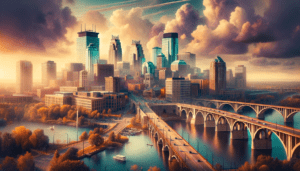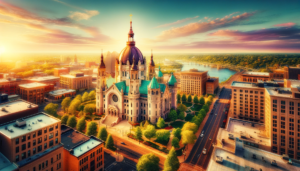
Safety Score
United States

High
Exercise Normal Precaution

Known For
- 10 thousand lakes
- Outdoor activities
- Friendly people
- Museums
- Parks
- Shopping malls
- Snow sports
 Covid Status
Covid Status

Risk Level
High
Vaccination Progress
Daily new cases
100k
Infection rate
Positive test rate
% Vaccinated
Minnesota is located in the Midwestern region of the United States. It's bordered by Canada to the north, North Dakota and South Dakota to the west, Iowa to the south, and Wisconsin to the east, with Lake Superior at its northeast corner.
The capital of Minnesota is Saint Paul. It is located in the southeastern part of the state, adjacent to Minneapolis, forming the "Twin Cities" metropolitan area.
The most common entry point for international travelers is through the Minneapolis-Saint Paul International Airport (MSP), which offers direct and connecting flights to many international destinations.
The major cities in Minnesota include Minneapolis, Saint Paul, Rochester, Duluth, and Bloomington. Each city offers a variety of attractions, from cultural institutions and shopping to outdoor activities and historical sites.
Northern Minnesota, including areas like the Boundary Waters Canoe Area Wilderness, the North Shore of Lake Superior, and various state parks, are popular for outdoor activities such as hiking, canoeing, fishing, and camping.
Yes, Minnesota is known for its "10,000 lakes," though there are actually over 11,000. The state is also home to the source of the Mississippi River at Itasca State Park, and the impressive shoreline of Lake Superior which includes the scenic Split Rock Lighthouse and the dramatic cliffs of Palisade Head.
The best time to visit Minnesota depends on what you want to do. Summer is ideal for lake activities and outdoor events, autumn features beautiful fall foliage, and winter is great for snow sports. Spring can be unpredictable with remnants of winter weather and the onset of warmer temperatures.
Having a car is the most convenient way to travel around Minnesota, especially to more rural or natural areas. Major cities have public transportation systems, like buses and light rail in the Twin Cities. Intercity bus services and regional airlines provide connections between cities.
Yes, there are numerous historic landmarks, including the historic Fort Snelling in Saint Paul, the James J. Hill House, the Mill City Museum in Minneapolis, and the historic town of Stillwater. Native American history is also preserved in sites such as the Jeffers Petroglyphs.
Minnesota hosts several cultural events throughout the year, such as the Minnesota State Fair, one of the largest state fairs in the US, the Minneapolis Aquatennial, the Saint Paul Winter Carnival, and various music festivals like the Twin Cities Jazz Festival and Soundset. It's a good idea to check the local calendars for event dates when planning your visit.
 Covid Status
Covid Status

![16 Places to Avoid in Minnesota [TOURIST SAFETY GUIDE]](https://www.exploreist.com/wp-content/uploads/2023/09/ycazg-6lts0-300x169.jpg)